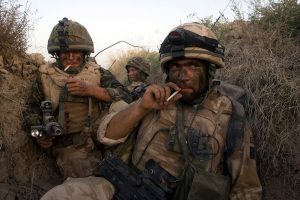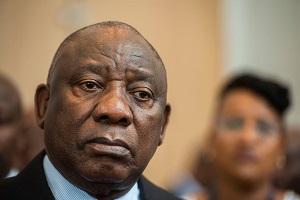
Photo: AFP/Noor Mohammed
03:10:2020
Taliban and government forces are face to face in Helmand with the resumption of peace talk-stalled hostilities the blink of an eye away
HELMAND – In a contested region of Afghanistan, the dividing line between the Taliban and government is a thin one.
Despite peace talks in Doha, Qatar, now in a second month without any conclusive progress towards a settlement, armed clashes continue in Helmand in the nation’s still volatile and hotly contested south.
While both sides talk of peace in Doha, on the ground in Helmand both sides are more apparently digging in for more fighting rather than forging reconciliation.
Helmand is in many ways the heart of Afghanistan. American and British special forces left the battlefield here in 2014, making the province into a symbol of the US-led military coalition’s failure and retreat.
After 19 years of war, Helmand still serves as the Taliban’s financial hub and until recently the headquarters of its military commission, which has since shifted to Quetta in southern Pakistan.
That influence is felt and seen on the road to Helmand’s provincial capital Lashkar Gah, a route that passes the Soviet-built Kandahar-Herat highway. The road, recently travelled by this correspondent, is now marked by desolate checkpoints covered in dust and barbed-wire.
Taliban forces without uniforms sporting moustaches and Kalashnikovs block the passage of vehicles and trucks in spots to ask for “contributions” of 50 or 100 Afghani, or little more than a US$1. “We are here to provide you security,” they say, “your support is welcomed.”
Unshaven drivers – that is those less likely to be loyal to the Islamic fundamentalist Taliban – often bypass the blocks by using narrow secondary roads, a trick also used by security forces avoiding roadside improvised explosive devices (IEDs).
In Helmand, with Taliban flags flying over the district of Naher-Seraj bordering on Lashkar Gah, sporting a beard is often enough to arouse government suspicion.
The Taliban previously sent traffic alerts to locals via text message, warning against leaving the main road to avoid IEDs and other mines. The southern region is still one of the most densely mined parts of Afghanistan.

Map: Facebook
“On one side,” explains Haji Rahman, a Lashkar Gah resident in his 30s, “the Taliban warn us of the dangers of driving away from the main road. On the other, government checkpoints block the passage, forcing us to take the dangerous smaller roads.”
From every side, Helmand’s residents are trapped. Nobody wants to cross the highway due to corrupt checkpoints, but the threat of mines strikes fear into the hearts of all travellers who are forced to move from village to village with the sound of gunfire constant in the air.
Since the end of NATO combat operations in 2014, the Afghan military took nominal control of the area, with all main passages connecting to the capital Lashkar Gah blocked. The Taliban, meanwhile, took over areas around Kreshk, Naher-Saraj and Nawa districts.
It’s an area, residents warn, where fighting could easily resume considering the proximity of Taliban and government forces.
“If the Taliban want to capture the Lashkar Gah,” says Sarhadi, “they can do it in a day, but they don’t. I believe they plan to remain close to the city and enter only in case the Doha talks collapse.”

The Taliban’s Helmand operations are run by a group of commanders led by Fazeli, the Taliban district governor of Sangin district.
The hardcore Taliban leader is known to be the younger brother of Yasser, the commander who conquered entire areas of Helmand in 2016 and who was later killed by a US drone. The attack remains a sore point among Taliban supporters.
“Yasser was in Baba-Jai area of Lashkar Gah leading an operation when his nephew used the mobile for a call. Shortly after the call ended, and they entered the car, the drone hit the vehicle killing Yasser, his brother and three of his nephews,” recalled a close aide of the Taliban commander, who wished to remain anonymous.
Fazeli took over the leadership from his deceased brother soon after he was freed from government custody in early September, a prisoner release that was brokered as part of a Taliban-US agreement in Doha earlier this year.
Fazeli was arrested a few years earlier in the vast wilderness of sand known as the Registan desert while allegedly transporting suicide bombers from Pakistan.
A close aide of the ex-commander said he took the name Yasser as a nom de guerre and was responsible for orchestrating the capture of Lashkar Gah’s district 4.
This allowed the Taliban to move the battle-line to the Bolan area of the provincial capital’s district 3, where the roundabout is named after Ahmad Wali Karzai, the infamous brother of former president Hamid Karzai, is located.
The government’s national security service (NDS) office is situated only 1.5 kilometres from there. If the talks in Doha break down, a Taliban drive to take all Lashkar Gah would likely be on the cards, locals say.

In 2016, US airstrikes blocked the Taliban offensive and forced the local commander to stop the advances. “The Taliban planned to capture Lashkar Gah but American interference stopped their plans,” said Haji Ustad, a resident of Sangin.
“They bombed the battle line of Sangin district, near the old bazaar, killing two Taliban and wounding others,” he explained recalling the airstrikes at the time.
The southern capital, known for its new buildings and American development engineering programs, still carries visible signs of past battles and the human suffering they caused.
Locals called the city “Little America,” but the bullet holes marking many of the buildings have cancelled out hopes of any “American Dream” or near-term prosperity.
Indeed, despite thousands of UK soldiers and US Marines being located there for more than a decade, Helmand remains the Taliban’s true military headquarters.
“The areas captured by the Taliban in 2016 are in their control,” explained Kakar, a former local teacher. “Government offices are on the other side of the bridge.”
It is only a river that separates government offices, state-protected modern housing blocks and their nearby markets from residential areas under the Taliban’s influence.
“The reality is that [the] Taliban control Babajai, Dashti-e-Bolan and a large part of residential areas of [Helmand’s] Nawa district,” added Sarhadi, speaking of areas around the provincial capital. “But if you look at Facebook, these areas are under government control.”
And while peace talks in Doha appear to be making little if any progress, the lines in Helmand are still clearly being drawn based on military rather than peace strategies.
Posted with permission of the author – Fazelminallah Qazizai







0 Comments